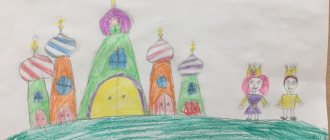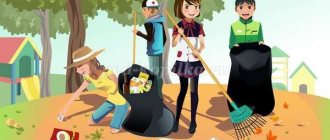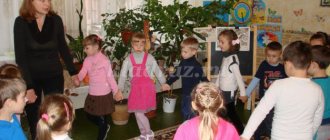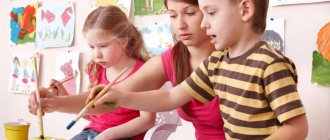Summary of GCD in the preparatory group. In a forest clearing
Summary of GCD in the preparatory group on the topic “In a forest clearing”
Teaching children of senior preschool age to compose descriptive stories based on a subject picture and a supporting plan.
Author: Sidorova Olga Sergeevna, teacher Place of work: MBDOU No. 6 Purpose: Compiling stories and descriptions of insects using subject pictures and a reference plan. Tasks: - activate the vocabulary on the topic;
— clarify the names, external characteristics, structure of insects; — exercise children in selecting definition words for each insect; - practice selecting nouns with diminutive - affectionate suffixes; - practice selecting singular and plural nouns; - practice using R.p. nouns in speech. singular; - teach children to guess insects by the actions they perform; - develop voluntary attention and verbal-logical thinking of children; — to cultivate love and respect for the beautiful places of our native nature and their inhabitants. Equipment: projector, design board; demonstration and handout pictures depicting insects (butterfly, bee, fly, dragonfly, ladybug, ant, etc.); supporting picture plan 6 (illustration 6). Progress of the lesson
The teacher and the children enter the group.
Educator: Children, look how many guests came to us today. Say hello to them. Educator: Children, do you like to solve riddles?
I. Intellectual warm-up
Teacher: Then try to guess my riddle: (tells the children a riddle). The snowball is melting, the meadow has come to life, the day is coming - when does this happen? Educator: Correct. What time of year is it now? Educator: Look at our magic screen, it will help us today. SLIDE 2 Educator: What signs of spring do you know?
(Snow and ice are melting, the days are getting longer, and migratory birds that spent the winter in warm regions arrive.) With the beginning of spring, migratory birds return. Why are they coming back? (There was enough food: insects appeared.) The riddle contains the words: “the meadow came to life,” but what does this mean, how did it “come to life”? (Children talk about sprouting grass and insects appearing.) II.
Main part of the lesson 1. Introductory part. Educator: Today we will take a trip to a forest clearing to look at the insects that live there. Sit down in your seats and imagine that we are traveling on a bus, and to make it not boring, I will tell you about the insects that we are going to observe. SLIDE 3 Bus Insects. There are a great variety of insects on earth. On their abdomen they have transverse stripes, like notches. This is where the name “insects” comes from - from the word “to infest.” Insects are big and small. Some fly, others crawl or jump. Some live for several years, others for one day. Insects have six legs. Their bodies are covered with a hard shell called the exoskeleton. The body of each insect can be divided into three parts: head, thorax and abdomen. They usually have two pairs of wings, although flies, for example, only have one. Insects appear on the surface of the earth only when it is warm - in spring or summer. The bright coloring of many insects warns other animals that they are inedible. Many insects use color to hide from enemies (butterflies, grasshoppers). Birds eat insects. SLIDE 4- 8 Didactic game “Big - small” We have our first stop! Here we will play the game “Big - Small”. I will show you a picture of an insect, you need to name it and think about what its baby will be called. Educator: you completed the task correctly! Let's move on! SLIDE 9 Bus SLIDE 10-14 Educator: How great you are doing. If you like to play, then I have also prepared an interesting game: “One - many.” I will tell you one insect, and you will tell me a lot...” Well done, you completed the task correctly! Let's move on.. SLIDE 15 Bus Educator: Do you know that among insects there are pests - carriers of human and animal diseases; There are also useful ones - they pollinate plants, provide food and raw materials (honey, wax, silk). Sometimes people are compared to insects. Guess what kind of person we can say about: “hardworking like a bee”, “annoying like a fly”. Educator: Next stop: SLIDE 16-17 Look, insects are having fun in this clearing. Look and tell me who is missing? Educator: You coped with this task too. Now we’re going straight to the magic meadow. SLIDE 18 Bus SLIDE 19 An image of a forest clearing appears on the screen. Educator: Here is the forest clearing! But for some reason there is no one in the clearing! Look, guys, who came to us? Children: Scientist cat. Educator: Now we will learn everything from him. Scientist Cat appears: Hello guys. Educator: Hello, Cat. Cat: I decided to ask you riddles and questions. If you can complete my tasks, the insects will stop hiding and return to the forest clearing. Educator: Whoever guesses the riddle and answers the Cat’s questions will receive a picture of this insect. 2. Guessing riddles. Cat: 1. All four petals of the flower were moving, I wanted to pick it, It fluttered and flew away. (Butterfly) SLIDE 10 Question from the Scientist Cat: How does a butterfly eat? (Butterflies land on flowers and feed on their nectar, reaching it with their proboscis.) 2. Housewife flies over the lawn. If he fusses over a flower, he will share the honey. (Bee) SLIDE 11 Question from the Scientist's Cat: Why is this insect so noticeably colored? (The bee, as it were, warns everyone: don’t touch me, otherwise I’ll sting you!) 3. In the summer it flies all day, it gets boring for you, the night will come, then it will stop. (Fly) SLIDE 12 Question from the Scientist's Cat: Why is a fly considered a harmful insect? (She carries dirt and harmful microbes on her paws.) 4. The blue airplane sat on a white dandelion. This is a girl, She has a thin waist, Huge eyes. It flies and chirps. (Dragonfly) SLIDE 13 Question from the Scientist Cat: How many wings and how many legs does a dragonfly have? (She has four wings, six legs.) 5. Forest “bug”, Black head, Wings - red, dots on the wings. (Ladybug) SLIDE 14 Question from the Scientist Cat: Why is the ladybug called that? (She secretes a special orange milk for protection. The bright color reminds the birds that ladybugs are not very pleasant to the taste.) 6. In a clearing near the fir trees, a house is built of needles. It is not visible behind the grass, but there are a million residents in it. They are forest dwellers, friendly builders. (Ants) SLIDE 15 Question from the Scientist Cat: Why are ants called “forest orderlies”? (Ants are beneficial insects. They destroy a large number of harmful insects.) Educator: Let's populate our forest clearing with insects. SLIDE 16 Insects appear on the screen in a clearing. Physical education minute. Attention game "Ant - grasshopper - butterfly." At the command of the teacher “Ant” the children squat, at the command “Grasshopper” they jump, at the command “Butterfly” they “fly”. 3. Compilation of stories and descriptions of insects according to the points of the picture plan. Cat: Children, I will ask you to complete my last task - to write descriptive stories about insects that you remember. After all, all insects are so different! Make up a story about any insect using the pictures from our plan. Educator: Well, guys, let’s complete the task? SLIDE 17 A picture plan appears on the screen. Children write a descriptive story. Cat: Thank you guys, you completed my task, I really liked your stories. But it's time for me to say goodbye, see you guys. And as a parting gift, I want to give you a surprise basket. Goodbye, see you again! Educator: Goodbye Cat, thanks for the surprise basket and see you soon.
Guys, look, all the insects have returned to the forest clearing. And now it’s time for you and me to return home... III. Summing up the lesson
The teacher sums up the lesson, thanks the children for their efforts, and notes the children’s most successful stories.
We recommend watching:
Synopsis of an integrated GCD. Preparatory group Synopsis of the GCD in the preparatory group Synopsis of direct educational activities in the preparatory group on the topic: “Where did I get the Abstract of the open GCD in the preparatory group for OO “Cognition”. Composition of number 7
Similar articles:
Methodological development of direct educational activities in the preparatory group on the topic “Cheerful guys”
GCD "In a forest clearing"
Integration : Artistic and aesthetic development, cognitive development, speech development, social and communicative development.
Tasks:
- Strengthen the ability to correlate the artistic image and means of expression, select material for independent artistic activity, and skills in visual arts. (Artistic and aesthetic development.);
- To consolidate knowledge about the food chain in nature, to form an idea of the rules of behavior in the forest (Cognitive development.);
- Activate and replenish children’s vocabulary, form connected speech (Speech development.);
- To form the foundations of environmental culture and safe behavior in nature.
Material: Silhouettes of birds (tit, woodpecker, sparrow) and wild animals. hard and soft brushes for each child, glue, plasticine, paper and salted colored dough, pieces of torn colored (brown, orange) paper, finely chopped colored wool thread (brown, orange and white), napkin - for each child.
Methods and techniques:
Verbal: Questions for children, explanations, instructions, pedagogical assessment.
Visual: Looking at bird silhouettes.
Practical: Simulation.
Preliminary work . Bird watching on a walk; games; viewing illustrations; reading poems, learning theme songs.
Logic of continuous educational activities
The teacher draws the children’s attention to a “magpie” (made of paper) that has flown into the group.
Educator : Guys, look, a magpie has flown to us. She seems to be alarmed about something and calls us to follow her. Let's go get her.
(The bird takes the children to the “forest clearing.”)
Educator: Guys, look, the bird led us to a forest clearing. But something is wrong with the clearing. What do you think?
Children: There are no forest inhabitants visible in the clearing: wild animals and birds.
Educator: Guys, what animals and birds could you see in the clearing?
Children: Wolf, fox, hare, wild boar, elk, squirrel, titmouse, swallow, sparrow, starling.
Educator: Let's ask the magpie what happened? Where have the forest abodes gone?
(A recording of a chirping magpie sounds.)
Educator: Guys, the magpie said that tourists visited the forest. They violated the rules of behavior in the forest, and therefore wild animals and birds left their homes: some nests, some burrows, and some their lair). Guys, we need to tell people about the rules of behavior in the forest, in nature.
(The teacher invites the children to each take a sign reminding them of the rules of behavior in the forest and talk about it.)
Children: This sign prohibits destroying nests.
This sign prohibits making a fire in the forest.
This sign prohibits cutting down trees.
This sign prohibits throwing trash in the forest.
This sign prohibits playing music and making noise in the forest.
This sign prohibits unnecessary tearing of plants in the forest.
This sign prohibits taking dogs into the forest in the spring and early summer, when animals breed, since dogs instinctively destroy nests and destroy baby animals.
This sign prohibits catching beautiful butterflies and insects.
This sign prohibits catching and taking home wild animals.
Educator: Guys, let's correct the mistake that people made.
(The teacher invites the children to make forest inhabitants from the material for creative work and populate the clearing with them. The child himself chooses the material for the creative activity and the methods for making it. In the process of creative activity, the teacher monitors the quality of the craft, if necessary, uses the techniques necessary to achieve the intended goal child's activities.)
Educator: Guys, place predatory wild animals to the left of the tree, and herbivorous wild animals to the right of the tree.
If any of the wild animals is not completed, then the teacher should say the following:
Educator: Guys, what wild animal is missing from the forest clearing?
Children: The hare is missing.
Educator: Guys, we will definitely choose the time and make a hare, because if we exclude it from nature, what could happen?
Children: We can disrupt the food chain in nature.
Educator: That’s right, and this could lead to an environmental disaster: animals will die of hunger.
(A magpie chirps, the teacher tells the children that the bird thanks the children for saving nature, that now it will not be lonely, and the entire bird choir gives the children their cheerful trill.)



